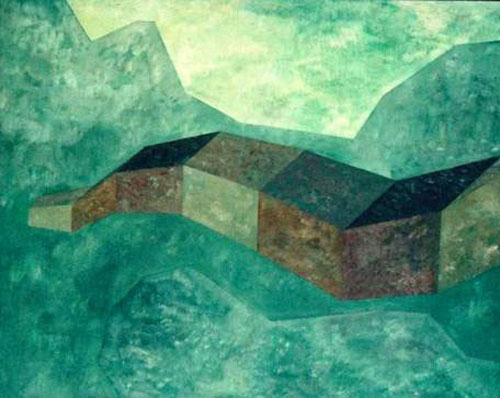Javier Calvo. Works donated to Valencia University
|
Javier Calvo. Works
donated to Valencia University
From April 20 to May 1, 2012
Oberta Room – La Nau Cultural Centre
From
Tuesday to Saturday, from 10 to 14 and from 16 to 20 h.
Sunday, from 10 to 14 h.
|
|
Folleto [+] |
| |
|

Praying mantis,
1977 · Mixed technique on canvas, 114 x 146 cm. |
| |
|
Organised by Universitat de València
Coordinated by Norberto Piqueras and Maria José Navarro
Javier Calvo completed his education at San Carlos
Higher School of Fine Arts in 1965. He then furthered
studies in Paris with a scholarship granted by the
Ministry of Foreign Affairs, where he was a student to
the lyrical abstract artist Gustave Singier. His Paris
trip allowed him to be part of a unique context, being a
direct witness of the May 1968 student protest. This
period of social upheaval and personal concern can be
seen in his works with a plurality of artistic languages
that range from Expressionism and Pop-art to Collage.
Structural problems, an interest in space, and geometric
order moved gradually to the foreground, which caused
him to drop figurative art for good. The search for
plastic purity and formal language put him in contact
with one of the bipolar trends that prevailed in the
1950s Spanish art scene, namely Geometric Abstraction.
From his early equations and modular exercises, he moved
on to more complex and symmetric compositions, using
flat geometric figures in black in the centre of the
painting from which a linear mesh comes out, this
element in turn generating other octagonal and
triangular shapes with a high chromatic perception
featuring pink and violet shades. (See Inscribed
square). |
| |
|
 |
 |
|
|
|

Inscribed square,
1971 · Acrylic on wood, 80 x 123 cm. |
| |
|
In his Itineraries, the artist studies a number
of compositions with geometric trajectories that shape
open ways towards infinity, with tension and trapezoidal
movement and, at the same time, he makes the use of
white lines evident as a way to fix colour and stake
boundaries (See Mobile triptych). Javier Calvo’s
in-depth study about his Itineraries takes him to
labyrinthine shapes that break space up by means of
polyptics, i.e. angular, volumetric and closed
structures but without curves. (See G-shaped
itinerary and Itinerary towards autumn). In
his last geometric period, he breaks away from symmetry
and starts playing with space, changing the course of
his works whose surface is sensitised by means of matter
and cloudscapes; it is no longer flat but more
expressive and subtle (See Praying mantis).
Geometric postulates lost momentum as from 1977, when
Calvo started his series Malvarosa, an
introspection into his memories as a child and a way of
bringing figuration back but with a marked linear
influence in the structure of figures and the
background. The Constructivist period took him to the
foreground of Valencian art but his figuration/geometrization
duality is constant throughout his career. |
| |
|

G-shaped itinerary,
1974 · Mixed technique on canvas, 50 x 50 cm. Each side |
| |
|
Lastly, his interest in donating his five paintings to
the collection of Universitat de València was raised by
an exhibition held at La Nau Cultural Centre,
Imaginary. Through the eyes of mathematics, which
showed works from the university collection by geometric
artists contemporary with Javier Calvo. His absence from
the show caused him to make a donation to the
institution for its commitment with culture. |
| |
|

Itinerary towards autumn,
1974 · Mixed technique on canvas, 97 x 130 cm. |
| |
|
 |
 |
| |
|
Javier Calvo developed his Constructivist period from
the late 1960s to the second half of the 1970s,
inheriting the will of rapprochement between a more and
more technological and scientific society and an art
secluded by a view very far away from post-modernity.
This new uniting trend between scientific-technical
culture and artistic-literary culture found motivation
in the figure of Vicente Aguilera Cerni, a Valencian art
critic, who –resorting to Gestalt psychology- set
up the group Antes del arte (1968), a
methodological experience and method to try to explain,
logically and rationally, the creation of the work of
art. The collaborating artists would not lose their
freedom, as this experience was not constrained to fixed
trends and dogmas but opened to a necessary renewal of
art on the basis of scientific, mathematical and
calculus models. Javier Calvo would occasionally meet
with Antes del arte: on the one hand, in the
exhibition Antes del arte III. Serie Matemática,
held at the mythical gallery Eurocasa in Madrid 1969,
and on the other with the cycle Arte y Ciencia,
held in Seville in 1970. His first geometric works of a
structural nature, symmetric configuration and plastic
purity evolved towards the so-called Itineraries,
in which he experimented with broken angles in an
elegant tour, sometimes open and sometimes closed, this
giving way to his last period, one in which surfaces
were sensitized, showing the different finishes of a
formal but also subjective and poetic language. Calvo is
indeed one of the most outstanding figures from the
second generation of abstract geometry artists of
Valencia. |
| |
|

Mobile triptych,
1973 · Synthetic paint on wood, 55 x 44 cm. Each part. |
| |
|
|
|